1997 GMC SIERRA ECU
[x] Cancel search: ECUPage 17 of 436

The extended cab's rear seat can also be folded up to
provide more cargo space. To
fold the seat:
1. Pull forward on the RELEASE lever at the side of
the seat cushion, behind the passenger's side front
seat. Fold the seatback forward
until it latches with
the seat cushion.
2. Lift the entire seat and
push
it rearward into
place.
3. Make sure the seat is secure.
Rear Seat (Crew Cab)
You can adjust the seat by sliding the lever at the front
of the seat toward the seat support to unlock it. Then,
slide the seat to where you want
it. Release the lever and
try to move the seat with your body
in order to make
sure the seat
is locked into place.
Safety Belts: They're for Everyone
This part of the manual tells you how to use safety belts
properly. It also tells you some things you should not do
with safety belts.
And
it explains the Supplemental Inflatable Restraint
system, or air bag system.
A CAUTION:
- -
Don't let anyone ride where he or she can't wear
a safety belt properly. If you are in a crash and
you're not wearing
a safety belt, your injuries
can be much worse. You can hit things inside the
vehicle or be ejected from it.
You can be seriously
injured or killed. In the same crash, you might
not be
if you are buckled up. Always fasten your
safety belt, and check that your passengers' belts
are fastened properly too.
1-9
ProCarManuals.com
Page 23 of 436
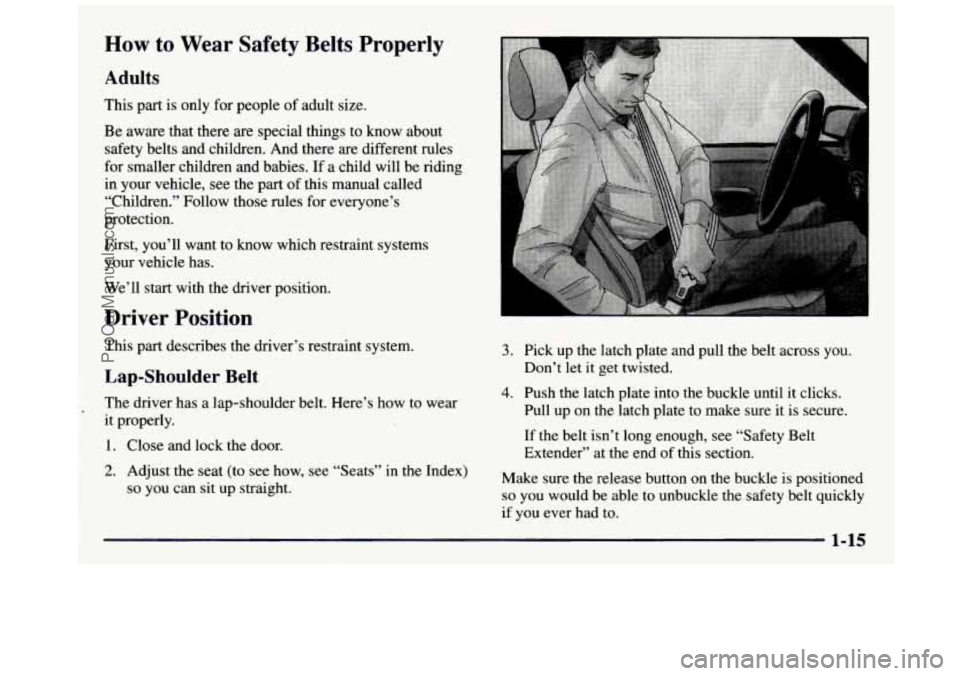
How to Wear Safety Belts Properly
Adults
This part is only for people of adult size.
Be aware that there are special things to know about
safety belts and children. And there are different rules
for smaller children and babies.
If a child will be riding
in your vehicle, see the part of this manual called
“Children.” Follow those rules for everyone’s
protection.
First, you’ll want to know which restraint systems
your vehicle has.
We’ll start with the driver position.
Driver Position
This part describes the driver’s restraint system.
Lap-Shoulder Belt
The driver has a lap-shoulder belt. Here’s how to wear
it properly.
1. Close and lock the door.
2. Adjust the seat (to see how, see “Seats” in the Index)
so you can sit up straight.
. ..
P‘
, :: hl
3. Pick up the latch plate and pull the belt across you.
Don’t let it get twisted.
4. Push the latch plate into the buckle until it clicks.
Pull up on the latch plate to make sure it is secure.
If the belt isn’t long enough, see “Safety Belt
Extender” at the end of this section.
Make sure the release button on the buckle is positioned
so you would be able to unbuckle the safety belt quickly
if you ever had to.
1-15
ProCarManuals.com
Page 32 of 436
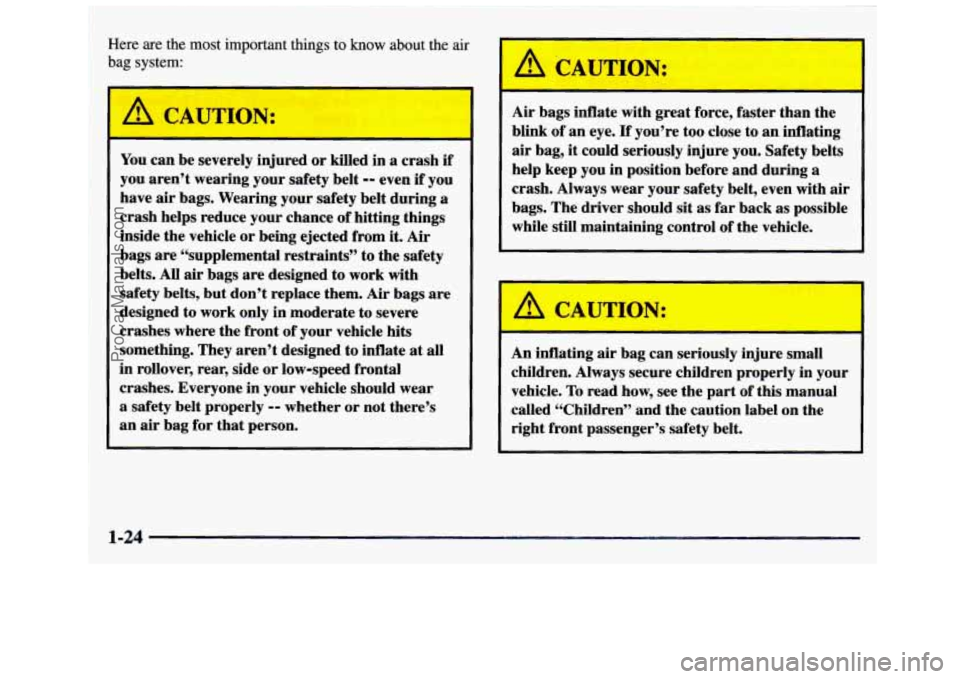
~ Here
are the most important things to know about the air
bag system:
A CAUTION:
You can be severely injured or killed in a crash if
you aren’t wearing your safety belt -- even if you
have air bags. Wearing your safety belt during a
crash helps reduce your chance of hitting things
inside the vehicle or being ejected from it. Air
bags are “supplemental restraints” to the safety
belts. All air bags are designed to work with
safety belts, but donY replace them.
Air bags are
designed to work only in moderate to severe
crashes where the front
of your vehicle hits
something. They aren’t designed to inflate at all
in rollover, rear, side or low-speed frontal
crashes. Everyone in your vehicle should wear a safety belt properly
-- whether or not there’s
an air bag for that person.
A CAUTION:
Air bags inflate with great force, faster than the
blink of an eye.
If you’re too close to an inflating
air bag, it could seriously injure you. Safety belts
help keep you in position before and during a
crash. Always wear your safety belt, even with air
bags. The driver should sit as far back as possible
while still maintaining control of the vehicle.
An inflating air bag can seriously injure small
children. Always secure children properly in your
vehicle. To read how, see the part
of this manual
called “Children” and the caution
label on the
right front passenger’s safety belt.
I
1-24
ProCarManuals.com
Page 37 of 436

In many crashes severe enough to inflate an air bag,
windshields are broken by
vehicle deformation.
Additional windshield breakage may also occur from
the right front passenger air bag.
Air bags are designed to inflate only once. After they
inflate, you’ll need
some new parts for your air bag
system. If you don’t get them, the air bag system
won’t be there to help protect you
in another crash.
A new system will include air bag modules and
possibly other parts. The service manual for your
vehicle covers the need to replace other parts.
Your vehicle is equipped with a crash sensing
and diagnostic module, which records information
about the air bag system. The module records
information about the readiness
of the system,
when the sensors are activated and driver’s safety
belt usage at deployment.
Unless you have a Crew Cab, your vehicle has a
switch on
the instrument panel that you can use to
turn off the passenger’s air bag. But use this switch
only when
you want to secure a rear-facing child
restraint at the right front passenger’s position. See
“Securing a Child Restraint in the Right Front Seat
Position” in the Index for more on this, including
important safety information.
A CAUTION:
If the right front passenger’s air bag is turned
off, an adult or a child who is no longer an infant
sitting in the right front passenger’s position
won’t have the extra protection of an air bag.
In
a crash, the air bag wouldn’t be able to inflate
and help protect the person sitting there. Make
sure the air bag
is turned on unless you are using
a rear-facing child restraint in the right front
seat position.
ProCarManuals.com
Page 43 of 436
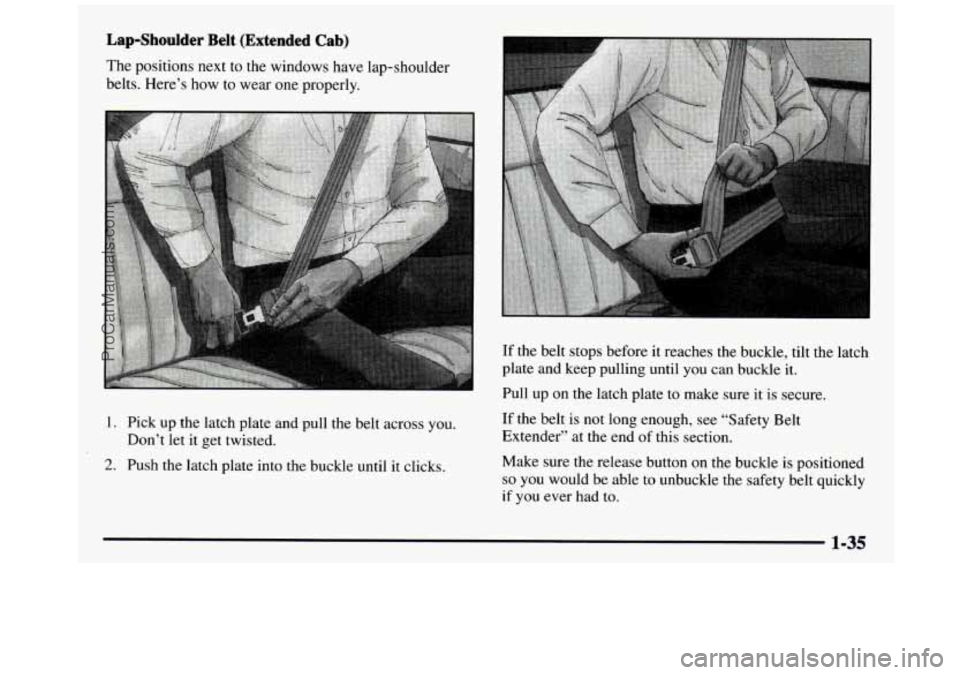
Lap-Shoulder Belt (Extended Cab)
The positions next to the windows have lap-shoulder
belts. Here’s how to wear one properly.
.. I
1. Pick up the latch plate and pull the belt across you.
2. Push the latch plate into the buckle until it clicks.
Don’t let
it get twisted. If
the belt stops before it reaches the buckle, tilt the latch
plate and keep pulling until you can buckle it.
Pull up on the latch plate to make sure it
is secure.
If the belt is not long enough, see “Safety Belt
Extender’’ at the end
of this section.
Make sure the release button on the buckle is positioned
so you would be able to unbuckle the safety belt quickly
if you ever had to.
1-35
ProCarManuals.com
Page 46 of 436
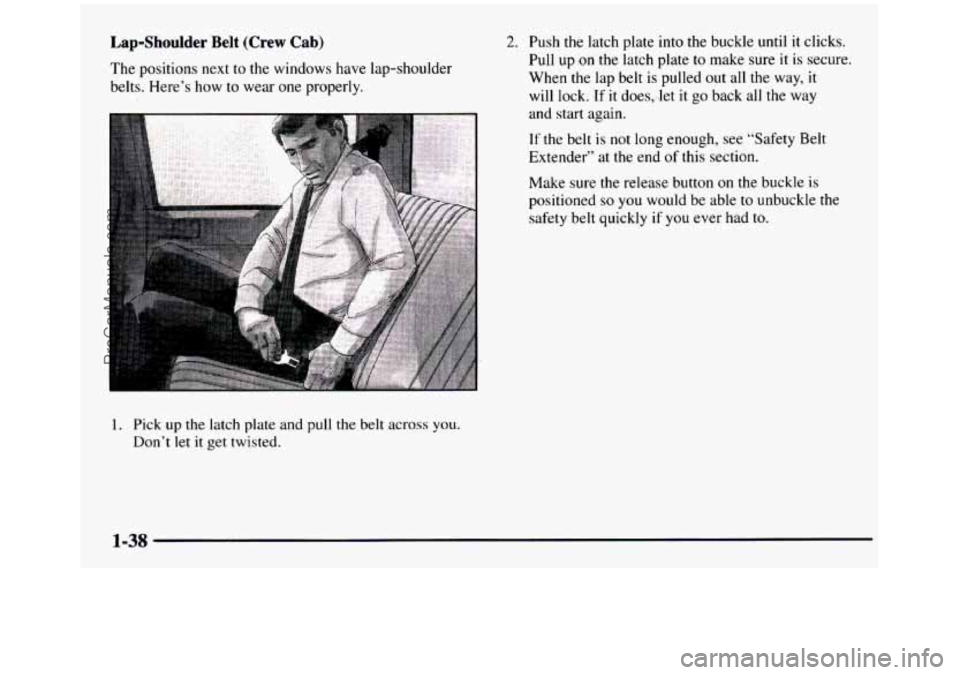
Lap-Shoulder Belt (Crew Cab)
The positions next to the windows have lap-shoulder
belts. Here’s how to wear one properly.
2. Push the latch plate into the buckle until it clicks.
Pull up on the latch plate to make sure it is secure.
When
the lap belt is pulled out all the way, it
will lock. If it does,,.let it go back all the way
and start again.
If the belt
is not long enough, see “Safety Belt
Extender” at
the end of this section.
Make sure the release button
on the buckle is
positioned
so you would be able to unbuckle the
safety belt quickly if
you ever had to.
1, Pick up the latch plate and pull the belt across you.
Don’t let it get twisted.
1-38
ProCarManuals.com
Page 52 of 436
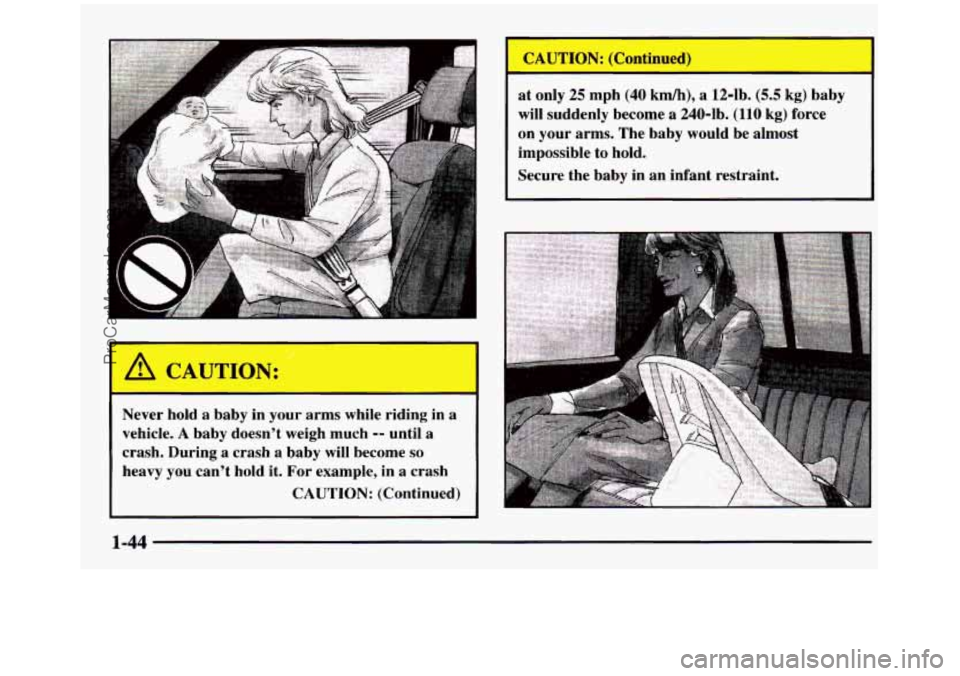
Never hold a baby in your arms while riding in a
vehicle.
A baby doesn’t weigh much -- until a
crash. During a crash
a baby will become so
heavy you can’t hold it. For example, in a crash
CAUTION: (Continued) at
only
25 mph (40 km/h), a 12-1b. (5.5 kg) baby
will suddenly become a 240-lb. (110 kg) force
on your arms. The baby would be almost
impossible
to hold.
Secure the baby in an infant restraint.
1-44
ProCarManuals.com
Page 53 of 436

Child Restraints
Be sure the child restraint is designed to be used in a
vehicle. If it is, it will have a label saying that it meets
Federal Motor Vehicle Safety Standards.
Then follow the instructions for the restraint. You may
find these instructions
on the restraint itself or in a
booklet, or both. These restraints use the belt system in
your vehicle, but the child also has to be secured within
the restraint to help reduce
the chance of personal injury.
The instructions that come with the infant or child
restraint will show
you how to do that.
Where to Put the Restraint
(Except Extended Cab and Crew Cab)
The child restraint must be secured properly in the
center or right front passenger seat. If your vehicle has
air bags and
you want to secure a rear-facing child
restraint in the right front passenger’s seat, you need to
turn
off the passenger’s air bag. See “Securing a Child
Restraint
in the Right Front Seat Position“ in the Index
for more on this, including important safety information.
I
--
A child in a rear-facing child restraint can be
seriously injured if the right front passenger’s air
bag inflates. This is because the back of a rear-facing child restraint would be very close to
the inflating air bag. Be sure to turn
off the air
bag before using a rearfacing child restraint in
the right front seat position.
Keep in mind that an unsecured child restraint can move
around
in a collision or sudden stop and injure people
in the vehicle.
Be sure to properly secure any child
restraint
in your vehicle -- even when no child is in it.
1-45
ProCarManuals.com